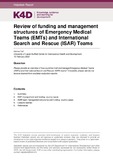| dc.description.abstract | When disasters exceed the capacity of the affected country to cope within its own resources, assistance from external source teams is required and typically requested (Bartolucci et al., 2019). Assistance can be Emergency Medical Teams (EMTs - also known as Disaster Medical Teams [DMTs] or Disaster Medical Assistance Teams [DMATs]) and/or International Search and Rescue (ISAR) teams. However, as the structures of these teams differ greatly, their management is paramount to success. Also, the cost of international relief, and the belief that such deployment is cost-effective, has been questioned by the international community.
Although overall management and centrally pooled funding is available for EMTs and ISAR teams, this rapid review focuses on organisation and funding at the country and/or regional level. As requested, EMT examples are taken from Australia, China, India, Israel, Malaysia, and the Caribbean. Data on ISAR teams is from Brazil, China, Germany, Indonesia, Scandinavia, and the United States (USA). The assessed ‘grey’ literature included: (i) external evaluations commissioned by funding agencies and/ or humanitarian EMT providers; (ii) institutional reviews of lessons learned; (iii) after-action reports, and (iv) formal reviews commissioned by the authorities of some of the sudden onset disaster (SOD) affected countries. Findings from response to natural disasters (de Ville de Goyet et al., 2003), and conclusions of five Tsunami Evaluation Coalition (TEC) thematic evaluations (de Ville de Goyet, 2007) were used extensively. However, since these publications, there still are few detailed data and evaluations available on EMTs and ISAR teams (Gerdin et al., 2013; Bartolucci et al., 2019). Experts consulted for this rapid review also confirmed this. | en |

